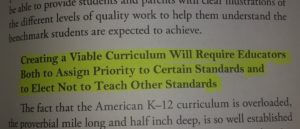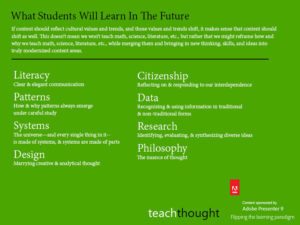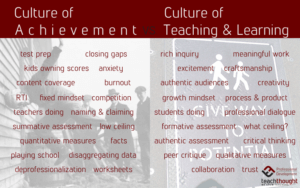What Are The Barriers to More Authentic Teaching and Learning?
contributed by Drew Perkins
School should be different. Teaching should be different. Learning should be different. In most cases it’s not.
The pieces and parts of most schools and school days looks eerily similar to what many of us experienced decades ago but with more advanced technology. We see teachers working their tails off to push students toward content mastery squinting through some of the latest tech tools in an effort to propagate the illusion of relevance.
We see students wondering why they should learn this or that content, asking when they’ll ever use it, and fighting the battle of compliance with adults who keep asking them to do work that seems to be more for the institution than the learners.
It doesn’t have to be this way. Many teachers and students are aching for things to change and some in leadership positions to help build capacity in teachers for more authentic teaching and learning.
So why aren’t we making more progress?
Rigid Curriculum and Content Standards

When schools and teachers are bound to pacing guides and curriculum maps they’re operating in an artificial and contrived environment. Authentic learning is more organic and doesn’t fit well with this sort of scripted approach. Part of the problem is that we’re trying to teach too many standards.
In his latest book, In Praise of American Educators: And How They Can Become Even Better, Dr. Richard DuFour makes an almost heretical statement calling for prioritization of certain standards and not teaching others. Imagine if schools actually went through the process of prioritization by asking themselves, “which standards are important and why?” Doing this with a lens of authenticity would be a huge step in the right direction!
Fear of Testing and Accountability Scores
I’ve lost count of how many times teachers have told me that they’d love to do more authentic teaching and learning but they can’t because they are responsible for test scores. The irony of this is that while it may feel like you’re doing your job as a teacher by “covering content” and getting those kids ready for the test it is fools gold.
One of my favorite stories from working with a math teacher years ago revolves around this misconception. She was (justifiably) terrified to change her teaching practice because of recent legislation that tied student performance to her pay. As she stopped and started the process of trying to come up with an authentic project-based learning experience for her students she came to me at lunch on day two of our workshop.
Wiping away tears she stated that she thought she had an idea that she would feel comfortable developing. A few questions into our conversation I asked when she would implement this project. She noted that she was planning on trying this near the end of the school year, after testing. When I asked if it would be new learning (thus the reason for it being after testing) she responded, “no, it would be stuff I’ve already taught but they would have forgotten it by then.” I sat quietly for a moment as she realized what she’d said.
We don’t open the school doors for teachers to teach, we open them for students to learn. We must shift away from testing and accountability as drivers of our pedagogical decisions.
Schedules and Silos

Other than teachers, adults in the ‘real world’ don’t go through their day in segments of math, social studies, science, language arts, etc. So why do our students? What if our school days didn’t have the regular movement of students from silo to silo, timed by bells and schedules?
If we want student learning to be more authentic wouldn’t it make sense to make it more like life outside our school walls? Some of the best schools I’ve seen have rethought and redesigned these systems and practices to allow for more organic movement of students and learning based on what they need to know for their current context.
While we’re at it what if we redesigned those ‘subjects’ with a nod toward contextualization by thinking about more modern subject areas?
Educator Practice
Authentic learning can be a difficult shift. It can be scary. While it may remind us of some of our most memorable moments from when we were students it can feel like we’re setting ourselves up for the natives to run wild and cause us the kind of stress that leads to heartburn and hair loss. I know this because I took the leap but came out on the other side feeling liberated and more confident in my ability to meet the needs of my students.
Of course that doesn’t mean everything will go smoothly with no hiccups or problems but the reality is that the illusion of control we can feel as educators is really the sense that we’re winning the battle of compliance. If we really had control of our students wouldn’t test scores be tremendously better?
Moving your practice toward more authentic learning takes time and support because you’re allowing for mistakes, reflection, revision, and growth. As elementary teacher Nan Arant notes in our podcast, Ep. 44 A Teacher Tells How Project-Based Learning Has Impacted Her Teaching, her first post-workshop project had lots of hits and misses but was transformational for her practice in a way that has rejuvenated her love of teaching.
It is important though for both teachers and leaders to engage in it as a long-term process not just an experiment to be quickly abandoned because it didn’t go perfectly. Collaborative learning experiences are a great start but if you want to avoid an implementation dip it’s best to engage in more depth. Tuning and alignment, observation and feedback, and reflection/revision sessions as well as adding regular practices to your PLC’s and staff interactions that support and grow authentic learning practices help to bring up questions, issues, and barriers to be resolved.
Policymakers

Let’s be real. Both sides of the aisle have contributed to a giant mess of policies, rules, and laws that seems to do nearly everything possible to run counter to authentic learning. No Child Left Behind signed into law in 2002 by George W. Bush pushed schools to create a culture of achievement, not one of teaching and learning.
In 2009 Barack Obama and Secretary of Education Arne Duncan brought us Race to the Top which did nothing but dig us deeper into testing and accountability. At some point our legislators and policymakers will have to play along but it’s going to be tough sledding. Ultimately it’s much easier to line student test scores up and compare them for successes and failures and many parents play along.
If parents really knew and understood what school could and should look like they’d force lawmakers to make changes but when the newspapers and national media trumpet great schools as largely defined by test scores it’s hard to expect much different. Learning is messy and sometimes tedious.
Authentic assessment takes time with qualified professionals and is often inefficient. Real learning and thinking is not reflected in numbers, it’s a narrative that reflects a process of growth that doesn’t often occur in straight lines. Our laws and policies need to reflect this.
If we truly want to prepare our students for real life it’s time we stop asking them to play school and start making learning more authentic.
Image attribution: Oleg Afonin
